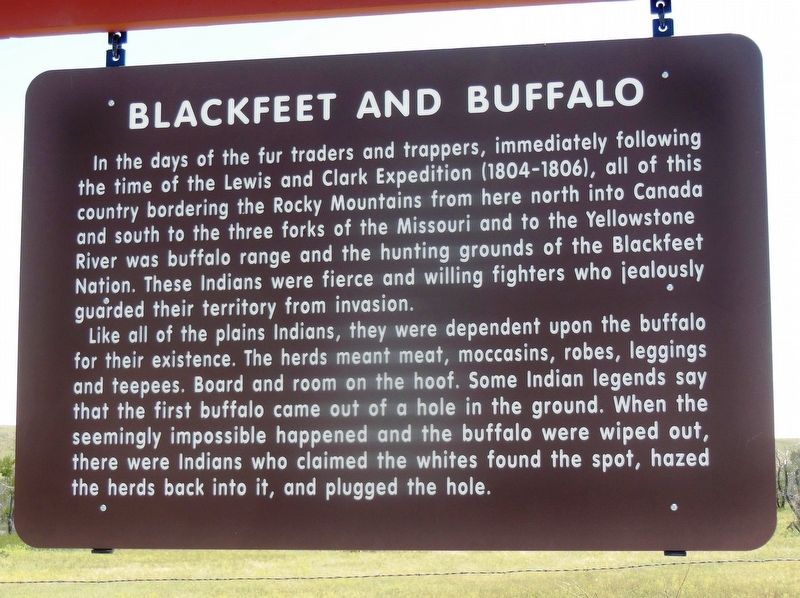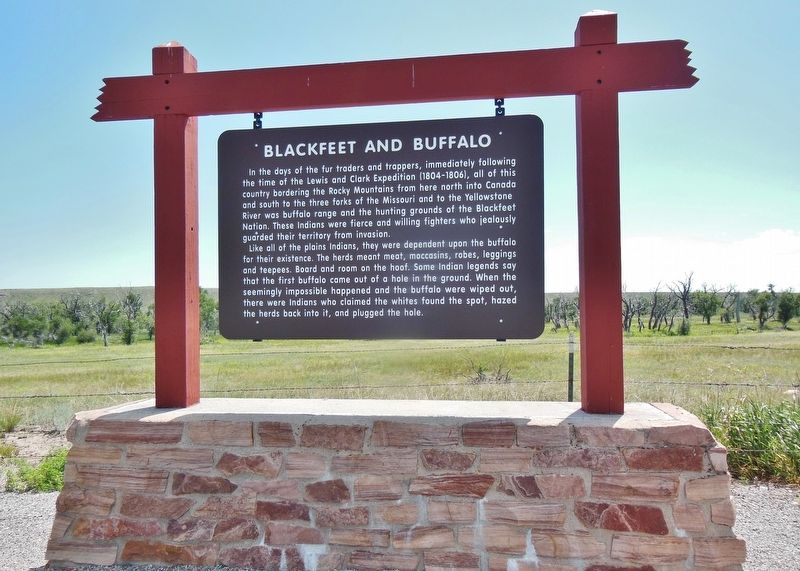Near Choteau in Teton County, Montana — The American West (Mountains)
Blackfeet and Buffalo
Like all of the plains Indians, they were dependent upon the buffalo for their existence. The herds meant meat, moccasins, robes, leggings and teepees. Board and room on the hoof. Some Indian legends say that the first buffalo came out of a hole in the ground. When the seemingly impossible happened and the buffalo were wiped out, there were Indians who claimed the whites found the spot, hazed the herds back into it, and plugged the hole.
Topics. This historical marker is listed in these topic lists: Animals • Industry & Commerce • Native Americans • Settlements & Settlers.
Location. 47° 51.641′ N, 112° 15.584′ W. Marker is near Choteau, Montana, in Teton County. Marker is on U.S. 89 south of Teton Canyon Road, on the right when traveling south. Marker is located in a pull-out on the south side of the highway. Touch for map. Marker is in this post office area: Choteau MT 59422, United States of America. Touch for directions.
Other nearby markers. At least 3 other markers are within 11 miles of this marker, measured as the crow flies. Old Agency on the Teton (approx. 1.4 miles away); Teton County Courthouse (approx. 5 miles away); Egg Mountain (approx. 10.2 miles away).
More about this marker. This is a large painted wooden "billboard-style" marker, hanging from a heavy timber frame mounted in a stone pedestal.
Also see . . . Blackfeet: All About Bison. Historically, Blackfeet were nomadic bison hunters and trout fishermen, who ranged across large areas of the northern Great Plains of Western North America, specifically the semi-arid short-grass prairie ecological region. In the first half of the 18th century, they adopted horses and firearms acquired from European-descended traders and their Cree and Assiniboine go-betweens. Through the use of horses, Blackfoot and other Plains peoples could expand their range for hunting bison. But, it was the systematic commercial bison hunting by European-American hunters that nearly ended the bison herds and permanently changed the Native American societies of the Great Plains, as their main food was no longer abundant. Periods of starvation and deprivation for the Blackfoot followed. They were forced to end their nomadism and adopt ranching and farming, settling in reservations made up of small pieces of their former lands. During the 1870s, the Blackfoot signed treaties with the United States and Canada, ceding their lands in exchange for annuities of food and medical aid, and help with farming. (Submitted on December 10, 2018, by Cosmos Mariner of Cape Canaveral, Florida.)
Credits. This page was last revised on December 13, 2018. It was originally submitted on December 10, 2018, by Cosmos Mariner of Cape Canaveral, Florida. This page has been viewed 395 times since then and 44 times this year. Photos: 1, 2. submitted on December 10, 2018, by Cosmos Mariner of Cape Canaveral, Florida. • Bill Pfingsten was the editor who published this page.

